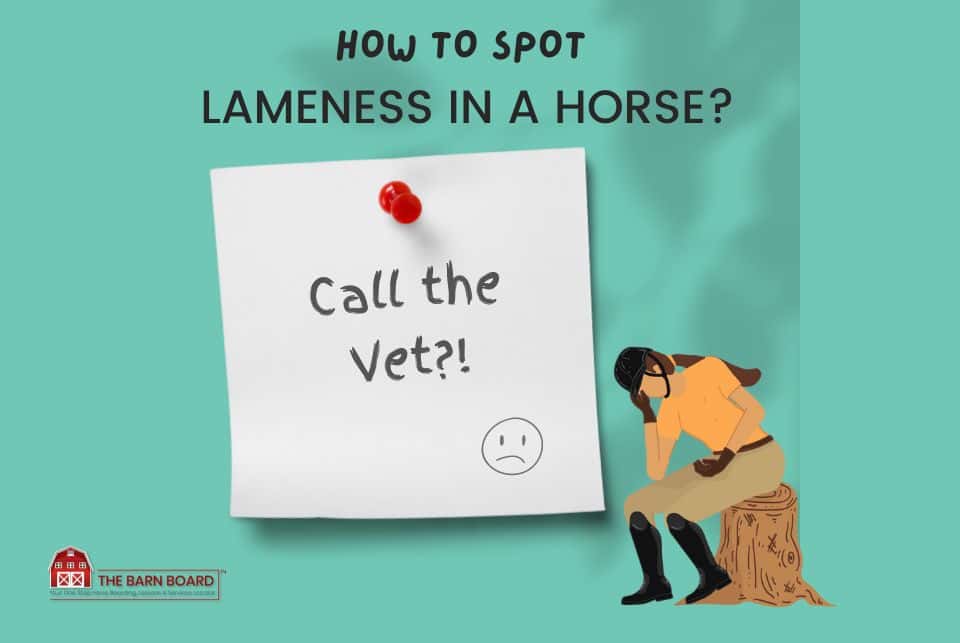Lameness is a term that refers to having an abnormal gait or stance usually caused by disorders in the musculoskeletal system that cause pain. Horses show reluctance to move or bear weight when having this condition.
Lameness is not a disease. It is rather a clinical sign of a problem in the hoof or leg.
A veterinarian would perform a series of checkups before identifying the causes of lameness and how severe the condition is. Early diagnosis plays a significant role in fast and complete recovery from lameness. So providing prompt veterinary care is crucial for a better prognosis.
Further exercising and weight-bearing worsens the situation. Therefore horse owners and caretakers need to have an understanding of detecting a lame horse.
Lameness ranges from being very mild to severe.
When the horse shows signs of lameness like limping, but no visible cuts or injuries on the foot or no apparent swellings can be seen, detecting which foot is causing the problem becomes a little bit complicated. Subtle signs are often hard to identify.
Even though you don’t see much difference in the horse when in stable, you will detect something incorrect when riding on its back. Particularly a change in gait.
Usually, lame horses are reluctant to move or bear weight on foot with the problem. But even if they do so in the earliest stages of lameness, you will still feel a difference in the gait and behavior of the horse.
LAMENESS CLUES
Here are some clues you can use to detect lameness:
- Change of temperament. The horse looks withdrawn and won’t go near other horses by isolating himself in a corner. It can show grumpiness and aggression towards the owner as well.
- Change of behavior. The horse will spend more time laying down or standing up than usual in order to deal with pain. If standing from the laying position seems to cause more pain, the horse will try not to lay down.
- Increased sweating can be a sign of pain. If the horse is sweating more than the weather, performing a physical examination before contacting a veterinarian is good. Take your palm from the head area, passing the whole body towards each limb. Perform this for all four limbs. Check for signs of discomfort or pain such as ear pinning, kicking, skin flicking while doing that. Check for any apparent swellings or increase of heat in localized areas.
- Urinating and passing manure at a higher rate than normal is also a sign of pain.
- Make your horse run in a circular track in both directions. Check for differences when taking bends and pay attention to its trot. The lame signs will be apparent when moving circularly compared to straight lines.
- Listen carefully for the footfalls. All four footfalls should sound similar in regular intervals under normal conditions. If one footfall sounds softer and the following one sounds louder, that means the horse doesn’t bear weight on the former, and the latter limb compensates that weight-bearing.
- During usual hoof cleaning, see whether the horse is reluctant to let you pick up a particular limb. There are two common reasons for this. Either the contralateral leg hurts, or the limb you are trying to pick up hurts when bent (due to some joint problem).
As mentioned before, swelling is only one of the signs of lameness.
The severity of the condition should be based on how lame the horse is and not on the amount of swelling (since swelling can have other causes too).
If the horse does not show much lameness and only swelling, try walking exercises, cold horsing, and applying firm, stable bandages.
If the swelling doesn’t go down and lameness show any progression, immediately contact the veterinarian.
Here are some other situations your horse needs to be seen by a veterinarian:
- If the horse refuses to bear any weight, a vet should observe it as soon as possible. But if the horse doesn’t show signs of lameness and the problem is only swelling in the leg area, immediate veterinary care is not necessary at that stage.
- If it shows mild lameness, but there is a wound on the lame limb. The wound might have damaged underlying muscles, tendons, or nerves. An open wound can cause microbial infection.
- If the limb shows a change in conformation or the wound shows the bone, you should contact the vet immediately.
- Persistent signs of pain such as excessive sweating, refusing feed, depression, and aggression.
A tip to keep in mind is even after detecting the problem and treating the lame limb, you still have to check the contralateral forelimb or hind limb to see for signs of secondary soreness. This happens due to overuse since that limb has been compensating the lame leg’s work for some time. This condition is particularly common in performance horses but can be seen in any horse.
If you have any questions, feel free to email us: info@thebarnboard.com or book a call!






